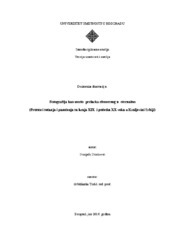| dc.contributor.advisor | Todić, Milanka | |
| dc.contributor.advisor | | |
| dc.contributor.other | Šuica, Nikola | |
| dc.contributor.other | Cvetić, Mariela | |
| dc.contributor.other | Todorović, Jelena | |
| dc.contributor.other | Matejić, Bojana | |
| dc.creator | Dimković, Danijela | |
| dc.date.accessioned | 2018-07-03T09:58:47Z | |
| dc.date.available | 2018-07-03T09:58:47Z | |
| dc.date.issued | 2018-10-30 | |
| dc.date.submitted | 2018-10-30 | |
| dc.identifier.uri | http://eteze.arts.bg.ac.rs/handle/123456789/320 | |
| dc.description.abstract | Ova disertacija predstavlja teorijsko interdisciplinarno ispitivanje načina na koji se fotografske slike enterijerskog prostora (Privilegovane Narodne banke s kraja XIX i početka XX veka), mogu koristiti u narativnom istraživanju. Sagledavanjem efemernosti arhitektonskog prostora i enterijera i njihovom mogućnošću uvođenja u
svestranu teoretizaciji studija kulture, teorija sećanja i pamćenja i naratologije koji
uključuju odnos prema prošlosti i formiranju identiteta. Efemerni prostor enterijera,
sećanje i pamćenje su pojmovi koji će se u ovom radu, u svom uzajamnom odnosu
prožimati ali i razilaziti na različitim nivoima i stoga zahtevati preciziranje osobenosti
svakog ponaosob a zatim i mapiranje njihove međusobne interakcije. Na samom
početku ukazuju nam se tri polazne teme koje su međusobno povezane, prva se bavi
efemernim prostorom koji je predstavljen kao kulturno trajanje uz pomoć medija
fotografije, druga se bavi praksom sećanja i pamćenja u odnosu na prošlost i treća se
vezuje za konstrukciju kulturnog identiteta posredstvom arhitektonske prakse. U našoj
problematizaciji, ovakav teorijski koncept bi predstavljao fotografiju koja nam
obezbeđuje neophodno pamćenje slikovnog jezika i samog efemernog prostora koji
prezentuje. Tačnije, fotografija u ovom slučaju vrši službu pamćenja, ona je
dispoziciona masa kojom ćemo se poslužiti u svrhe sećanja i iznošenja na površinu
podataka koje želimo da aktualizujemo i manifestujemo. Zatim se razmatra izgradnja
nacionalnog identiteta kroz odgovarajuće državne i kulturne institucije od kojih je
Privilegovana narodna banka Kraljevine Srbije svakako jedna od najznačajnijih.
Memorijalna arhitektura Holokausta, kao simbol pamćenja i sećanja, razmatra se kao
studija slučaja u okvirima multikulturalnog i multidisciplinarnog diskursa kulture
sećanja. | en |
| dc.description.abstract | This dissertation represents a theoretical interdisciplinary examination of the way in which photographic paintings of the interior space (Privileged National Bank from the end of the XIX and the beginning of the XX century) can be used in narrative research. By examining the ephemerality of architectural space and interior and their ability to be introduced in the comprehensive theorization of cultural studies, theories of memory and remembrance and narratology that include relationship to the past and identity formation. The ephemeral space of the interior, memory and remembrance are the concepts that in this work, in their interaction, will interweave and diverge at different levels, and therefore require the precise characterization of each individual and then mapping of their interaction. At the very beginning, three starting topics are related
to each other; the first deals with the ephemeral space, which is presented as a cultural endeavor with the help of photography as a medium, the second deals with the practice of memory and remembrance in relation to the past, and the third relates to the construction of cultural identity through architectural practices. In our problematization, such a theoretical concept would be a photograph that provides us with the necessary memory of the visual language and the ephemeral space itself that is being presented. More precisely, photography in this case performs the service of remembrance, it is a disposable mass that we will be used for the purpose of remembering and bringing to the surface of data that we want to update and manifest. Then, the construction of a national identity is being considered through the appropriate state and cultural institutions, of which the Privileged National Bank of the Kingdom of Serbia is certainly one of the most important. The memorial architecture of the Holocaust, as a symbol of memory and remembrance, is considered as a case study within the framework of a multicultural and multidisciplinary discourse of the culture of remembrance. | en |
| dc.language.iso | sc | en |
| dc.publisher | Универзитет уметности у Београду, Интердисциплинарне студије Универзитета уметности | sr |
| dc.source | Интердисциплинарне студије Универзитета уметности | sr |
| dc.subject | fotografija, teorija fotografije, enterijer, efemerni prostor, ideologija nacije i identiteta, sećanje i pamćenje, arhiv. | en |
| dc.subject | photography, theory of photography, interior, ephemeral space, ideology of the nation and identity, memory and remembrance, archive. | en |
| dc.title | Fotografija kao mesto prelaska efemernog u eternalno (Prostori sećanja i pamćenja sa kraja XIX i početka XX veka u Kraljevini Srbiji) | en |
| dc.type | doctoralThesis | en |
| dcterms.abstract | Тодић, Миланка; Тодоровић, Јелена; Матејић, Бојана; Шуица, Никола; Цветић, Мариела; Димковић, Данијела; | |


